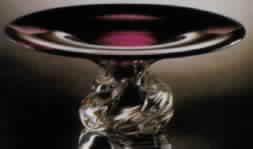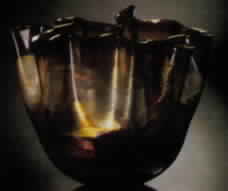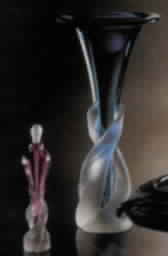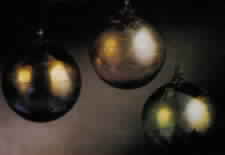| Thames Street Glass House | ||
| Written by Roserita Ziegler | ||
| The past several decades saw the closing of many old, established glass companies in the United States -- a sad and tragic chapter in our history. As labor costs and foreign imports continue to destroy a once thriving industry, there is one bright spot on the horizon -- the American Contemporary Art Glass Movement. Today, an ever growing number of men and women are contributing to our legacy by returning to basic American tenets of individualism, self sacrifice and hard work. They are producing art glass in small studios throughout the country. Compared to the large firms that hired hundreds of individuals and manufactured glass in staggering amounts, these small studios produce limited quantities. | ||
| |
||
| What does it take to create a successful hot glass studio and sales gallery in America today? If you are multitalented, as is Matthew Buechner, and fortunate enough to marry an attractive woman like Adrian Chapman (who shares your dreams and goals and can cat as business manager), the answer is ‘hard work and total commitment.’ | ||
| |
||
| Matthew had the good fortune of being born into an established American glass family. His father, Thomas S. Buechner, was president of the Corning Museum of Glass and vie president of Corning Glass Works. Brought up in Corning, New York, Matthew was exposed at an early age to one of our finest glass museums. Adrian also grew up in Corning and shares Matthew’s appreciation and enthusiasm for glass. When the demands of being wife, mother and business manager are not as great, she hopes one day to learn the art of glass blowing. | ||
| |
||
| In the 1970’s it was not easy to get a summer job, and this fact changed the direction of Matthew’s life. His father wisely suggested that he spend the summer learning to be a glass blower. Matthew’s natural design talents were channeled into the fascinating world of glass blowing. The summer of 1975 found him serving as an apprentice to glassblower Jon Meyer in Canton, New York. In 1977 he was a dull-time student at Hartwick College in Oneonta, New York, where he studied glass blowing with Michael Pavlik and worked with ceramics. | ||

| A year of disciplined training as a bit gatherer/apprentice making stemware at Glashutte Eisch in Frauenau, West Germany, gave Matthew the skill and confidence to return to this country. Together with his bother Tom and sister-in-law Barbara, he founded the Vitrix Hot Glass Studioin Corning, New York. Before leaving Germany, however, his glass was exhibited at a ‘One Man Show’ at the Frauenau Museum of Glass. | ||
| |
||
| Two years after establishing Vitrix, a love for the sea and the desire to have their own studio, drew Adrian and Matthew to Newport, Rhode Island. Newport, summer home to the wealthy and famous, is a thriving waterfront community with a restored historic district and a seafaring heritage. It is strategically located between two major market centers, Boston and New York. The new partners searched for a perfect location and found a one-story, red brick building at the lower end of Thames Street. Many months were spent transforming the former coffee shop into a hot glass and sales gallery. | ||
| |
||
| During this period Matthew exhibited his many talents. He designed the studio and constructed all the equipment needed to blow glass. A furnace was built that would run at 2300 degrees F. A glory hole was added to reheat the glass for shaping into a desired form. Matthew also made a marver -- a steel table used to roll glass while applying color and/or foil or frit. Glass must slowly return to room temperature, consequently an annealing lehr was built to allow up to fourteen hours of cooling. Smoothing and polishing glass required the building of a grinding station. | ||

| Adjacent to the studio is a spacious sales gallery painted off-white. Indirect lighting allows one to fully appreciate the color and artistry of the off-hand glass being made on the premises. A large window separates the studio and a gallery, which allows tourists and glass enthusiasts to observe the work being done in the studio. Pedestrians find it impossible to pass by the corner window without stopping in a few minutes to marvel at the skill and timing necessary to create each piece of glass. | ||
| The Thames Street Glass House, 688 Lower Thames Street, celebrated its Grand Opening on May 2-8, 1982. Since that time, the business has grown and prospered. A second story was added to the building to accommodated the glassblowers Matthew plans to train. It also provides space to meet increasing demand. Matthew’s first apprentice is Eric Heonowski, who continues to work with hot metal. | ||
| |
||
| A pamphlet distributed by the Thames Street Gallery describes its uniqueness: | ||
‘Each piece of glass from Thames Street Glass House is |
||
designed by Matthew and hand blown in our studio |
||
using traditional hand tools, wooden blocks, and wet |
||
newspaper. Being a designer as well as the craftsman |
||
allows Matthew the freedom to make aesthetic judgments |
||
about each piece even as he is making it. As a result, |
||
even though Matthew ‘produces’ the same design over |
||
and over again, he interprets it slightly differently each |
||
time, making each piece unique. This is in sharp contrast |
||
to a glass blower in a factory situation who must make each |
||
piece exactly to a designer’s specifications.’ |
||

| Eventually Matthew would like to hire enough glass blowers to produce giftware and moderately priced items to satisfy the growing retail market. Sales of Christmas ornaments, vases, perfume bottles, goblets and paperweights are brisk. With sufficient production of these items guaranteed, Matthew would have time to be creative and to experiment with the glass that appeals to studio art glass collectors. | ||
| |
||
| Creating an idea and seeing it through many stages to a sophisticated art form is a time consuming process. As Matthew explains, what appears to be a simple technique is oftentimes a tedious and painstaking procedure. For instance, the perfumes and bowls, made with silver and gold foil are difficult to fashion. Matthew admits that some of the higher priced items do not yield the percentage of profit that more moderately priced pieces do. This is in part due to the cost of the silver and gold foil. | ||
| |
||
| One design that has become the hallmark of the Thames Street Glass House is the Emerging Form. The flowing motion of colorless glass, sand blasted and entwining a clear glass form of rich vibrant color, has universal appeal. Emerging Form is available in perfume and two styles of vases and bowls. The perfume was chosen by the Smithsonian Institute for inclusion in a Smithsonian gift catalogue. | ||

| The life of a glass artists is one of continued learning and refinement of technique and design. Matthew has attended a lampworking session at Penland School conducted by Paul Stankard, the world renowned paperweight artist. He also attended a hot glass blowing workshop at the Rhode Island School of Design. | ||
| |
||
| We talked of hard work and total commitment. In just six years, Matthew and Adrian had opened and successfully expanded a glass studio and sales gallery. Matthew has continued his glass training and his work has been displayed at selected exhibitions in American, Japan, West Germany, England and Canada. | ||
| |
||
| Roserita Ziegler lives in Farmington, CT. and has been a glass historian, lecturer, and columnist for 27 years. For eight years she promoted and lectured at the Fenton Festivals, national retail promotions for the Fenton Art Glass Company. | ||
| Home | ||